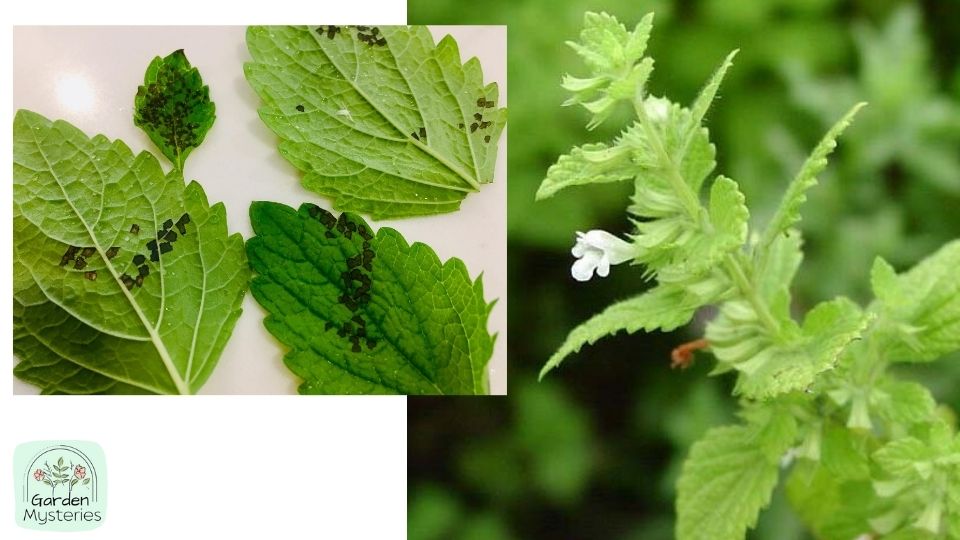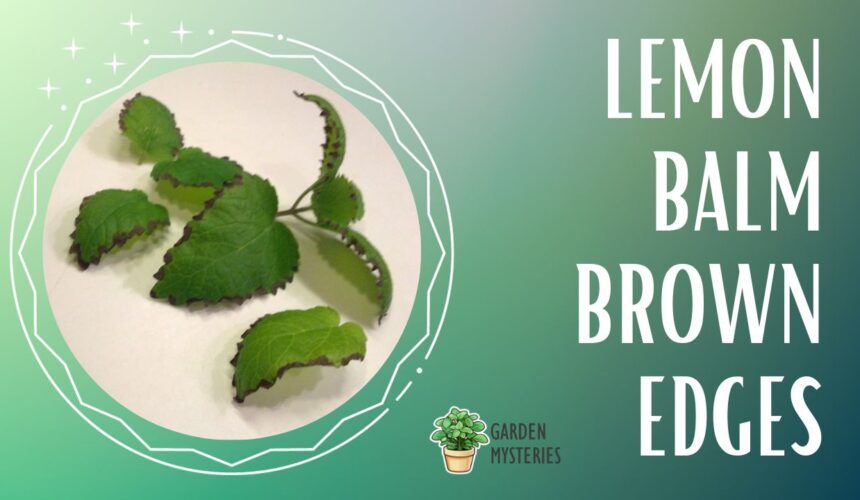Last year I bought my first-ever leaf balm for my balcony. But after a few days, I started to notice brown edges in its leaves. So I asked a professional gardener about lemon balm brown edges.
He told me that it happens due to various reasons including inadequate watering, overwatering, pests and diseases like septoria, and so on. So, stay focused and read the whole post.
Is It a Bad Sign for Lemon Balm to Have Brown Edge?
Yes, it is a bad sign for lemon balm has brown edges on its leaves. Brown edges indicate that the plant is experiencing stress or an underlying issue. This could be due to watering problems, environmental stress, nutrient deficiency, pests, diseases, improper pruning, root-bound conditions, or sunburn.
Neglecting the issue can lead to further decline and potential harm to the plant’s overall health. To ensure the well-being of your lemon balm, it’s crucial to identify the cause of the browning and take appropriate measures to rectify the problem.
By looking into the root cause, providing proper care, and maintaining a suitable growing environment, you can promote healthy growth and prevent further leaf damage. Regular observation and prompt action are essential to keep your lemon balm from seeds thriving.
Why My Lemon Balm Edge Become Brown?
Lemon balm leaves developing brown edges can result from a range of factors, each contributing to the plant’s stress and compromised health:
Inadequate Watering
When the lemon balm plant struggles to absorb enough water, leaves become dehydrated, leading to brown edges due to moisture deficiency. Thirsty tissues are scorched from insufficient hydration.
Overwatering
Excess water in the soil causes roots to suffocate, impeding their ability to absorb nutrients. This can lead to brown edges as the roots struggle to function efficiently.
Pests and Diseases
Insect infestations or fungal diseases can weaken the plant, affecting nutrient absorption and causing lemon balm brown edges on leaves. Pests like aphids and diseases like Septoria can lead to leaf damage.
Septoria, a fungal disease, causes small lesions on leaves that enlarge and turn dark brown with a purplish-brown margin. This leads to brown edges as the disease progresses.
Environmental Stress
Excessive sunlight exposure or dry conditions can cause water loss through leaves via transpiration, resulting in brown leaf edges. Inadequate humidity exacerbates this issue.
Soil Conditions
If the soil remains consistently wet, it can lead to root rot, which affects the plant’s ability to take up water. This root issue can manifest as brown leaf edges due to compromised root function.
Root Issues
Damaged or crowded roots impede the plant’s water and nutrient uptake, causing leaves to show signs of stress, including browning along the edges.
Stress or Damage
Environmental changes, improper handling, or physical damage can stress the plant, affecting its overall health. Brown edges may be a result of the plant diverting resources to recover.
Moreover, if you want to know other things like black spots on lemon balm leaves or lemon balm flowers, we will cover these topics later. Let us know in the comments if you are interested.

Cause & Solution: Lemon Balm Has Brown Edges
Here’s a cause and solution table for brown edges on (Melissa officinalis) lemon balm leaves:
| Cause | Solution |
| Inadequate Watering | Water the plant thoroughly, ensuring the soil is consistently moist but not waterlogged. |
| Overwatering | Allow the soil to dry slightly between waterings and ensure proper drainage. |
| Pests and Diseases | Regularly inspect the plant for pests and diseases. Treat with appropriate remedies if identified. |
| Environmental Stress | Provide partial shade during intense sunlight and maintain adequate humidity levels. |
| Soil Conditions | Ensure the soil has good drainage to prevent root rot. Re-pot if the plant has outgrown its container. |
| Disease (Septoria) | Remove affected leaves promptly and apply fungicides if necessary. |
| Root Issues | Repot the plant with fresh soil and address root damage or crowding. |
| Stress or Damage | Minimize environmental changes and handle the plant gently. Provide optimal conditions for recovery. |
Can you spare 5 more minutes? Check out our other article on Brown orchid root issues and solution.
What to DO When My Lemon Balm Edge Become Brown?
When your lemon balm edges become brown, it’s essential to take prompt action to address the issue and prevent further damage. Here’s what you can do:
Step 1: Check Watering
Ensure that you are watering your lemon balm appropriately. Keep the soil consistently moist but not waterlogged. Water when the top inch of soil feels dry. Adjust your watering schedule if necessary.
Step 2: Inspect Growing Conditions
Assess the plant’s environment for any potential stressors. Avoid exposing it to extreme temperatures, drafts, or direct sunlight, as these can contribute to leaf browning.
Step 3: Fertilize
If the browning is due to nutrient deficiency, consider fertilizing your lemon balm with a balanced, water-soluble fertilizer containing nitrogen. Follow the package instructions for application.
Step 4: Inspect for Pests and Diseases
Regularly check your lemon balm for signs of pests or diseases. If you identify any issues, take appropriate measures to treat them using organic or chemical solutions as recommended.
Step 5: Prune with Care
If the browning is caused by improper pruning, be cautious when trimming the plant. Avoid excessive removal of leaves and cut back no more than one-third of the plant at a time.
Step 6: Re-pot if Necessary
If your lemon balm is root-bound, consider repotting it into a slightly larger container with fresh, well-draining soil. Gently loosen the roots during repotting to encourage healthy growth.
By taking these steps and addressing the underlying causes of the browning, you can help your lemon balm recover and promote healthier foliage. Regular care, observation, and timely intervention will contribute to the overall well-being of your lemon balm plant. Then you can get lemon balm benefits at home.

Lemon Balm Maintenance Tips
Here are some useful maintenance tips for lemon balm in the next phase below:
- Sunlight: Lemon balm thrives in partial shade to full sun. Provide it with at least 6 hours of sunlight daily, preferably in the morning or late afternoon.
- Watering: Keep the soil consistently moist but not waterlogged. Water when the top inch of soil feels dry. Avoid letting the soil completely dry out between waterings.
- Soil: Use well-draining, loamy soil with good fertility. Adding organic compost during planting can improve soil structure and nutrient content.
- Fertilizing: Feed your lemon balm with a balanced, water-soluble fertilizer every 4-6 weeks during the growing season (spring to early autumn).
- Pruning: Regularly trim the plant to encourage bushy growth and remove any dead or damaged leaves. Prune by cutting just above a leaf node to stimulate new growth.
- Pest Control: Keep an eye out for pests like aphids or spider mites. If infested, use natural insecticidal soap or neem oil to control the problem.
- Disease Prevention: Ensure good airflow around the plant to prevent fungal diseases. Avoid overhead watering, which can promote leaf wetness.
- Harvesting: Harvest leaves throughout the growing season. Pinch off the tops to encourage branching and promote a compact growth habit.
- Container Growing: Lemon balm can be grown in containers. Ensure the pot has drainage holes and use a quality potting mix.
- Winter Care: In colder climates, lemon balm may die back in winter. Mulch around the base to protect the roots from freezing temperatures.
If you follow these maintenance tips, you can enjoy a healthy and thriving lemon balm plant that will provide you with its delightful fragrance and culinary uses throughout the growing season.
FAQs
Are there any natural remedies to treat brown edges on lemon balm leaves?
Yes, natural remedies include introducing beneficial insects to control pests, using neem oil to combat fungal diseases, and adjusting cultural practices such as proper watering and pruning. Maintaining a healthy growing environment is crucial for preventing and treating brown edges.
Can I trim off the brown edges to improve the appearance of my lemon balm plant?
Yes, you can trim off the brown edges, but it’s essential to identify and address the underlying issue to prevent further browning. Trimming helps improve aesthetics and encourages new growth, but it’s not a long-term solution if the cause isn’t resolved.
Is repotting a solution for brown edges on lemon balm leaves?
Repotting can help if root-bound conditions or soil issues are causing brown edges. Use fresh, well-draining soil and a slightly larger pot. However, repotting alone won’t solve the problem, and addressing the specific cause is crucial for successful treatment.
Lastly, we would like you to read our take on a popular fertilizer, Positive and Negatives about 16-16-8 Liquid Fertilizer for Corn.





